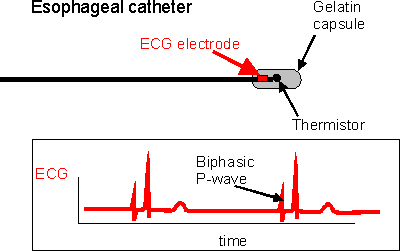Using esophageal temperature as the measure of body temperature offers the advantage of close correspondence to temperature in the pulmonary artery. However, some means of assuring that the temperature probe is placed in the lower esophagus is necessary, since catheters may tend to form into a "U" shape in swallowing so that the tip is high in the esophagus even though a sufficient length of catheter has been swallowed.

We use an electrode at the tip of the thermistor catheter to obtain an electrocardiogram. This enables us to place the catheter reproducibly in the segment of the esophagus that is pressed against the left atrium. A characteristic biphasic "P" wave marks this region.
The gelatin capsule shown on the catheter tip facilitates swallowing the thin catheter. About the size of a vitamin pill, it is filled with thick gelatin that holds it in place until it comes off after some time in the esophagus
Swallowing saliva disturbs esophageal temperature. Subjects held a suction catheter, similar to a dentist's, in their mouth and cooperated by swallowing only when they felt it necessary to moisten the throat.
Links: (this is the last of the sequence on
methods)
next page in the linear sequence beginning interpretation of results
rationale in experimental design(with
links to methods pages)
Summary data from experiments
return to index page